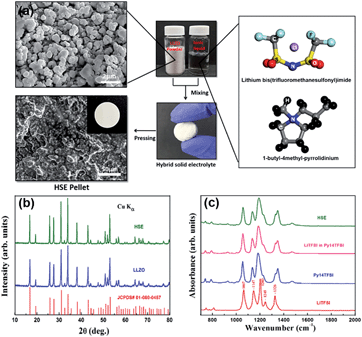Hybrid solid electrolyte with the combination of Li7La3Zr2O12 ceramic and ionic liquid for high voltage pseudo-solid-state Li-ion batteries
- Journal
- Journal of Materials Chemistry A
- Vol
- 4
- Page
- 17025-17032
- Year
- 2016
Concerning the safety aspects of high-voltage Li-ion batteries, a pelletized hybrid solid electrolyte (HSE) was prepared by blending Li7La3Zr2O12 (LLZO) ceramic particles and an ionic liquid electrolyte (ILE) for use in pseudo-solid-state Li-ion batteries. The LLZO particles are enclosed by the ionic liquid as a LLZO–ILE matrix, and are quantified by FESEM elemental mapping. The chemical stability of the LLZO in the ILE is confirmed by powder XRD and FT-IR analysis. The HSE, with an optimized weight ratio of 80% LLZO, 19% Py14TFSI, and 1% lithium bis(trifluoromethanesulfonyl)imide, exhibits good thermal stability, even at 400 °C. The optimized HSE reveals an ionic conductivity of 0.4 × 10−3 S cm−1 and an electrochemical stability of 5.5 V with Li metal. Pseudo-solid-state Li-ion cells are fabricated using the HSE, and afford initial charge–discharge capacities of 140/130 mA h g−1 (Li/HSE/LiCoO2) with 99% capacity retention at the 150th cycle. The scope of the HSE is widened to high-voltage (>8 V) pseudo-solid-state Li-ion batteries through a bipolar stacked cell design. Dendrite formation is hindered during cycling in the Li-ion cell. Hence, the present investigation will greatly contribute to the next generation of high-voltage pseudo-solid-state Li-ion batteries.

